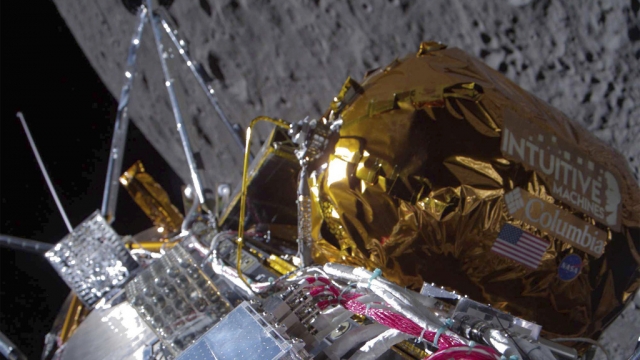The Odysseus lunar lander made a successful touchdown near the south pole of the moon Thursday evening, marking the first uncrewed U.S. commercial moon landing and the U.S.' first return to the moon in 50 years.
Officials with Intuitive Machines say they have received a faint positive return from their lander, which will still need refining and strengthening.
But they say it's enough to confirm that the landing was successful.
"Our equipment is on the surface of the moon, and we are transmitting," mission director Tim Crain said at 6:37p.m. Eastern Time.
Intuitive Machines decided to use experimental sensors on board the lander while it made its final approach to landing. The probe carries a laser range finder system to scan the ground below and exactly measure a spacecraft's speed and heading. The tool was originally meant to be tested during this mission for use in future probes, but Intuitive Machines switched over to using it full time during the landing.
The Odysseus lander is carrying experiments for NASA that will measure the radio emissions near the lunar surface that come from cosmic sources and from human activity. Tiny cameras also closely watched the probe's landing sequence to gather data about how rocket plumes will affect the lunar soil — which will be important to understand as missions to the moon get more frequent and deliver bigger payloads.
The probe is designed to function for seven days, after which it is expected to run out of power during the extended lunar night.
The last U.S. presence on the moon was in 1972, when Gene Cernan and Harrison Schmitt walked on the surface during the Apollo 17 mission.
Intuitive Machines is the first private company to make a successful landing. Until now, only five countries have managed to get a working probe to the surface: The U.S., Russia, China, India and Japan.
Flight controllers had decided to add one more orbit before beginning the IM-1 Mission landing sequence, which pushed the expected landing time two hours later than initially planned.
Intuitive Machines' lander touched down near the Malapert A region of the moon, which is a relatively flat spot among the collection of craters near the moon's south pole.
A SpaceX Falcon 9 rocket helped launch the lander into space last week from NASA's Kennedy Space Center.
The moon landing is part of NASA’s CLPS (Commercial Lunar Payload Services) initiative and Artemis campaign. NASA says CLPS and Artemis are helping scientists better understand our solar system and learn more about long-term human exploration of space.
“NASA scientific instruments are on their way to the moon — a giant leap for humanity as we prepare to return to the lunar surface for the first time in more than half a century,” NASA administrator Bill Nelson said after the launch. “These daring moon deliveries will not only conduct new science at the moon, but they are supporting a growing commercial space economy while showing the strength of American technology and innovation. We have so much to learn through CLPS flights that will help us shape the future of human exploration for the Artemis Generation.”
Intuitive Machines received $118 million from NASA to build and fly the Odysseus mission.
SEE MORE: Delta flight to follow moon's shadow during upcoming solar eclipse
Thursday's scheduled landing comes nearly a month after NASA abandonedits Peregrine Mission One.That mission was set to also include an uncrewed lunar landing, but after mid-flight issues arose, NASA opted to direct the spacecraft and its onboard lunar lander to reenter Earth's atmosphere.
NASA is set to send astronauts around the moon in September 2025 as part of the Artemis campaign. A crewed landing on the moon is set to follow in September 2026.
Trending stories at Scrippsnews.com




